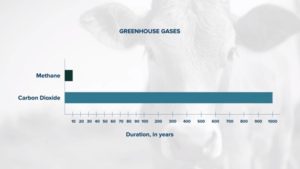
Methane emissions: livestock as part of the climate solution
Farms and meat production are frequently under attack, especially when it comes to greenhouse gas emissions. Cows are the main accused for methane emissions. Yet livestock can be part of the climate solution.
Everyone against cattle, everyone against its methane emitted. But is it the culprit when it comes to climate change? No, actually. Few people seem to consider that, although a methane molecule causes 28 times more greenhouse effect than a CO2 molecule emitted by the burning of oil and coal, it remains in the atmosphere for ten years, while carbon dioxide stands for a millennium. So, considering everything in terms of CO2 equivalent makes no sense, even for this reason. But above all, almost no one – at least in the “green” field, seems to accept that livestock is not the problem, but on the contrary, it could and should be part of the climate solution.
Almost no one, at least in the #green sector, seems to accept that #livestock is not the problem, but it could be part of the #ClimateCrisis solution. Click To TweetOf course, to do so, ideology (or partisan interests) must be left aside and finally to look at the science, to discover then surprising data. Methane has a powerful climate-warming effect. Once found ways that avoid emitting more of it into the atmosphere, be it from cattle, but also from marshes, rice paddies, or fossil fuel extraction – the only one always underestimated, thanks to livestock a drastic reduction in global warming can be achieved. The important thing is to start assessing and measuring the sources of global warming in the right way.
Thanks to #zootechnics, a drastic reduction in #GlobalWarming can be achieved. If we start measuring its real sources in the right way. Click To Tweet“If your question is: can we reduce global warming? The answer is yes, but we mismeasured the contribution of methane,” Frank Mitloehner explains, professor and air quality specialist at UC Davis’ Department of Animal Sciences, in this exciting video: “If we want to know what is the impact of a methane reduction on warming, the equivalence with the CO2 unit is wrong.”
If it is true that a methane molecule is equivalent to 28 carbon dioxide molecules over a hundred years, we must reiterate that methane does not remain in the atmosphere for a hundred years. It is a short-lived climate-warming gas, which, as mentioned above, remains in our atmosphere for about ten years before it is destroyed, which means it does not cause warming for hundreds of years. On the contrary, carbon dioxide remains in our atmosphere for 1,000 years, accumulating and continuing to heat for a long time after it has been emitted.

Methane from cattle is also part of the biogenic carbon cycle: with photosynthesis – as explained in the video – plants capture carbon dioxide from the atmosphere, absorbing carbon and releasing oxygen. That carbon is converted into carbohydrates by plants, which are then consumed by cows and then digested and released by animals as methane. After ten years in the atmosphere, methane is decomposed and converted into carbon dioxide. These molecules are the same carbon molecules found in plants eaten by animals: the carbon taken from plants’ atmosphere and returned to the atmosphere. In short, it is “recycled” carbon.
“Biogenic carbon is different because it completes a cycle. It is very different from fossil carbon, which goes one-way from below upwards in the air,” Professor Mitloehner points out: “If we keep constant the number of animals raised, the amount of methane produced by livestock balances that of methane destroyed. So there is no carbon added to the atmosphere and therefore no additional warming.”
The #CarbonDioxide emitted 20 years ago traveling by #car or #plane is still in the #atmosphere and will remain there for centuries. The #methane emitted by #ruminats, no. Click To TweetMethane from cattle is a “flow” gas because it is destroyed when it is emitted. On the contrary, fossil fuels’ carbon dioxide is a “stock” gas, which means that it accumulates in the atmosphere. In short, the carbon dioxide emitted today is added to the carbon dioxide emitted yesterday, which was added to the carbon dioxide of the day before, and so on. The carbon dioxide that you emitted maybe twenty years ago traveling by car or plane is still there in the atmosphere. It will remain there for another century. Methane emitted by the digestion of cattle does not. Therefore, CO2 generated by fossil fuels is not part of a cycle but is a one-way source of warming.
Short-term global cooling could be achieved thanks to livestock, which is crucial if global warming is to be kept below 1.5 degrees Celsius. “What excites me the most is that if we reduce methane from livestock, we actively subtract carbon from the atmosphere, almost as if we were to store atmospheric CO2 in the ground,” Mitloehner explains: “If you reduce methane produced by cattle, you subtract carbon from the atmosphere, and that brings global cooling.”
If #methane produced by #cows is reduced, #carbon is removed from the #atmosphere, and this induces the #GlobalCooling. Click To TweetBut can you do it? “It can be done, and it’s been done,” the UC Davis expert says: “Here in California, for example, we’ve managed to reduce methane by 25%. The way we reduced methane by 25% was through improvements in manure management. If you reduce methane, you have a strong cooling effect, which means that livestock is an important part of the solution to reduce our overall impact on the climate.”
Rethinking about methane allows us to focus on short- and long-term climate solutions while continuing to work to feed a growing population, experts point out. But to do this, farmers and breeders, control units, and researchers need to work together. Possibly without ideological blinkers that, in the end, do more damage to the climate than the unfairly accused cattle.





